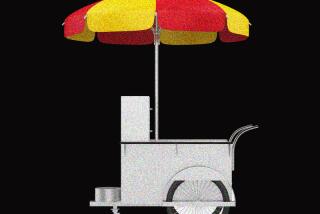Healthful vending machines are increasing, but do they help?
- Share via
Imagine: You’re hungry for an afternoon snack, just a little something to hold you over until dinnertime. You head down to the vending machine, drop in your change and walk back to your desk with … yogurt, some trail mix and a piece of fresh fruit.
That’s not quite the reality in most workplaces — at least not yet. But more and more vending machine companies are swapping out cookies and candy for granola bars and rice cakes.
The switch is driven by consumer demand coupled with a patchwork of new laws and regulations aimed at improving the way America eats. Some vending machine companies even boast that their machines are stocked exclusively with healthful snacks.
Nutrition experts are split on the trend. Some argue that snacking is contributing to this country’s high rate of obesity and that superficial changes to vending machine fare are unlikely to put a dent in the problem.
Others say it’s a small but meaningful change.
“People don’t get a lot of their calories from vending machines, so the impact will be very limited,” says Dr. Paul Simon, director of the division of chronic disease and injury prevention at the Los Angeles County Department of Public Health. Nonetheless, he adds, “I think it’s a move in the right direction.”
Much of the demand for more healthful vending machine fare has come from schools, according to Margo Wootan, director of nutrition policy for the Center for Science in the Public Interest, an advocacy group based in Washington, D.C.
Over the last decade, states have taken a variety of steps to improve school nutrition policies, she says. They’ve banned sodas, restricted sales of sweetened sports drinks and limited the amount of sugar and saturated fat in school snacks. Some states have set nutritional standards for food sold on campuses — in school stores, in cafeterias and even in vending machines.
In Alabama, individual vending machine snacks must provide no more than 30 grams of carbohydrates, 360 milligrams of sodium or 10% of the 65 grams of fat recommended by the U.S. Department of Agriculture for a child or teen consuming 2,000 calories a day; snacks also have to provide at least 5% of the daily value of at least one of the following: vitamin A, vitamin C, iron, calcium or fiber. In Connecticut and District of Columbia schools, juice drinks in vending machines must contain 100% fruit or vegetable juice and can’t have added sugars. In Kentucky, snacks must have no more than 300 milligrams of sodium and no more than 14 grams of sugar (unless they’re fresh fruits).
And in California, snacks, including those in vending machines, can’t derive more than 35% of their calories from fat (including a limit of 10% of calories from saturated fats) or contain more than 35% sugar. Elementary school snacks can’t exceed 150 calories, and middle and high school snacks can’t exceed 250 calories.
The new rules have prompted a number of entrepreneurs to launch healthful-vending-machine companies in the last couple of years, and many say business is booming.
Take, for example, Fresh Healthy Vending, a San Diego-based start-up that specializes in all-healthful-snack vending machines featuring products such as Stonyfield Farm yogurts and Tazo iced teas. The company got started 16 months ago and already has machines in 800 locations across 43 states, says Chief Executive Jolly Backer.
Backer says the demand for wholesome vending fare got an added boost last year from passage of the Healthy, Hunger-Free Kids Act of 2010. The federal law authorized the USDA to set nutritional standards for all foods sold in schools during the school day, including snacks in vending machines.
The USDA standards, scheduled to be released by the end of December, should eliminate the variation in local laws that permit the sale of, say, M&Ms and sodas in Alaska schools but not in Arizona.
However, just 13% of the vending machines in this country are found on academic campuses, from elementary schools through colleges. The majority of machines are in offices and factories, according to the 2011 State of the Vending Industry Report published by Automatic Merchandiser, an industry trade journal. And for the most part, standards for those machines have not been established, Wootan says.
In the last five years, a handful of local governments adopted vending nutrition policies that aren’t limited to schools. In San Francisco, the snacks in all vending machines on city property have to conform to calorie, fat and sugar limits. So do the vended snacks at all county facilities in Los Angeles.
Even in areas without such rules, consumer vending choices have shifted, according to the State of the Vending Industry report. Over the last few years, vending machine sales of candy and salty snacks have fallen while sales of “nutrition snacks” — a category that includes breakfast bars, granola bars, rice cakes and trail mix — have grown. In 2010 alone, nutrition snack sales increased 7.7% compared with 2009.
The vending industry has taken the lead in deciding what qualifies as a “healthful” snack in places where laws haven’t kept pace with consumer demand. For instance, the National Automatic Merchandising Assn., the top vending industry group, uses stickers to promote “Fit Pick” snacks, which have no more than 35% of calories from fat, 10% of calories from saturated fat and 35% of total weight from sugar.
In effect, these guidelines mimic those adopted by schools, says Marlene Schwartz, deputy director of the Rudd Center for Food Policy and Obesity at Yale University.
Some individual vending companies have come up with their own standards.
Aramark Refreshment Services’ Just4U program identifies products as “Cal Smart” (no more than 300 calories per serving), “Low Fat” (less than 30% of calories from fat), “Heart Healthy” (low in fat, saturated fat and cholesterol, with less than 480 milligrams of sodium), “Carb Counter” (no more than 15 grams of carbohydrates per serving), “Vegetarian” or “Vegan.”
Canteen Vending, the nation’s largest vending company, promises that at least 15% of the offerings in each of its machines are “better for you” items — meaning they have no more than 250 total calories, 35% of calories from fat, 10% of calories from saturated fat and 350 milligrams of sodium.
According to Canteen’s standards, several kinds of Baked Lay’s, a variety of Clif, Odwalla, Nature Valley, Quaker Oats, Nutri-Grain, Kashi and Special K bars, kettle corn, a few fruit snacks and several kinds of pretzels make the cut.
Items that qualify as Fit Picks include Bare Fruit Bake-Dried Bananas and Cherries, Pepperidge Farms Giant Goldfish Grahams (in cinnamon and chocolate varieties), Clif Bars, a wide variety of salted nuts, granola bars and cereal bars — along with 11 types of Pop-Tarts and seven kinds of non-baked Doritos, including Cooler Ranch and Nacho Cheesier.
Although lower in fat and calories, some of these so-called healthful items are very high in sugar, Schwartz says. Several of the Clif Bars contain 20 to 22 grams of sugar (the equivalent of roughly five teaspoons) per serving.
She adds that these guidelines focus on limiting “bad” things but don’t necessarily encourage people to eat snacks that are full of “good” things, such as whole grains, fiber and vitamins.
“Many of these products are nutritionally neutral,” she says. “It’s just something to stick in your mouth at 3 in the afternoon.”
Simon, of the L.A. County Department of Public Health, shares this concern. Just because something meets a limit on saturated fat, sugar or sodium content doesn’t necessarily mean it’s healthful, he says.
“Processed food is processed food. If only we could do fresh fruit” in these machines, he says.
Some companies do sell whole and cut fruits and vegetables in their machines. Aramark is rolling out machines that vend fresh bananas, apples, carrots, celery and grapes (depending on what’s in season), as well as salads and cottage cheese, says representative Sarah Jarvis.
But even when machines are stocked with wholesome fare, such as nuts, seeds and yogurt, still the processed foods are more popular.
Backer says the top-selling items in his machines include Pirate’s Booty (baked corn and rice puffs), Pop chips (potato snacks) and Tazo iced teas (some varieties contain as many as 121 calories and 31 grams of sugar in a 13.8-ounce single bottle). At Santa Monica-based H.U.M.A.N. (Helping Unite Man and Nutrition) Healthy Vending, top sellers include Pirate’s Booty, Kashi granola bars and Stacy’s Pita Chips, says founder and “chief humanist” Sean Kelly.
That said, such fare is better than the top-selling items from mainstream vending machines, according to the State of the Vending Industry report: Snickers bars, followed by Peanut M&Ms, Twix bars, Ruffles Cheddar & Sour Cream potato chips, Doritos Nacho Cheesier Big Grab, Lay’s chips, Cheetos Crunchy chips, Three Musketeers bars, Frosted Strawberry Pop-Tarts and Rice Krispie Treats.
Simon says he expects nutrition guidelines for vending machines to have the greatest effect by removing high-calorie sodas from schools and government offices. But he adds that all the fuss sidesteps a key issue: “Why do we even need vending machines?”
To some, the answer is obvious: We don’t. Especially not in schools, no matter how healthful the products supposedly are, says Marion Nestle, a professor of nutrition, food studies and public health at New York University.
“There is only one reason why they are there: profits for the vendors and maybe a pittance for the schools,” she says. “Vending machines didn’t used to be in schools, and they especially don’t need to be in them now.”
More to Read
Inside the business of entertainment
The Wide Shot brings you news, analysis and insights on everything from streaming wars to production — and what it all means for the future.
You may occasionally receive promotional content from the Los Angeles Times.










